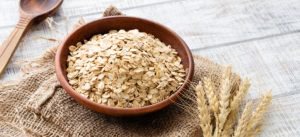Oats and oatmeal are often praised as one of the healthiest breakfast options around. Oats have been eaten for thousands of years. In addition to providing important nutrients to growing populations, they’ve also historically been important for feeding livestock.
Evidence shows that wild oats first grew in the Fertile Crescent of the Near East centuries ago, although humans didn’t domesticate these grains until the Bronze Age in Europe. For many years, oat grass was even used for health purposes and now even makes an appearance in many super green powders.
So how much nutrition do oats contain? You’ll be surprised to learn how oats are a great fiber food and plant-based protein, plus they feature many minerals and vitamins. As a result, oat benefits extend to helping lower cholesterol, relieving constipation, promoting potential weight loss and more.
What Are Oats?
Oats — which come from the plant with the scientific name Avena sativa — are a type of common whole-grain cereal grain grown for the seeds. According to BeyondCeliac.org, oats are technically gluten-free grains since they aren’t a type of wheat, barley or rye grain.
But while oats themselves don’t contain gluten, in many cases they are grown on the same land and in rotation with gluten-containing grains (wheat, barley and rye). Gluten grains can grow within oat crops if they’re planted in the field the previous year, in which case the oats become contaminated with gluten. To ensure that purchased oats are gluten free, look for a “Certified Gluten-Free” logo from
the Gluten-Free Certification Organization (GFCO).
Oats have many uses around the world beyond just being the base for a simple breakfast. For example, oat bread has been an important food for many cultures living in Europe for hundreds of years, especially the English, Irish and Scottish. They are also used in a variety of baked goods worldwide.
Nutrition Facts
Oats and oatmeal is one of the most popular whole grain recipes worldwide, and for good reason. Oat grains are a good source of fiber, trace minerals and even plant-based protein.
A half cup (about 40.5 g) of regular dried or quick dry oats (which makes about one cup of cooked oatmeal) contains approximately:
Calories: 153
Total Carbohydrates: 27.4 g
Fiber: 4.1 g
Sugar: 0.4 g
Total Fat: 2.6 g
Saturated Fat: 0.45 g
Polyunsaturated Fat: 0.9 g
Monounsaturated Fat: 0.8 g
Trans Fat: 0 g
Protein: 5.3 g
Cholesterol: 0 mg
Sodium: 4.9 mg (0.2% DV*)
Manganese: 1.47 mg (64% DV)
Selenium: 11.7 mg (21% DV)
Copper: 0.16 mg (18% DV)
Vitamin B1 (thiamin): 0.19 mg (16% DV)
Phosphorus: 166 mg (13% DV)
Zinc: 1.47 mg (13% DV)
Magnesium: 56 mg (13% DV)
Iron: 1.72 mg (9% DV)
Vitamin B5 (pantothenic acid): 0.45 mg (9% DV)
Folate: 13 mcg (3% DV)
*Daily Value: Percentages are based on a diet of 2,000 calories a day.
Benefits
1. Offers Excellent Nutrition
Oats are loaded with nutrition such as fiber, minerals, certain vitamins yet very low in sugar and relatively low in fat and calories.Eating gluten-free oatmeal regularly is a good way to obtain manganese, selenium, copper, phosphorus, zinc, magnesium and iron, as well as some B vitamins.
One serving of oats contains 64 percent DV of manganese. Manganese is important for maintaining a healthy bone structure since it plays a role in creating essential enzymes for building bones. It also supports your metabolism, energy levels, brain and hormonal balance.
One serving also contains 21 percent DV of selenium and 18 percent DV of copper. Research shows that consuming foods high in selenium can support detoxification and liver function, as well as hormonal and thyroid health. Copper is important for the function of several enzymes and proteins that are involved in energy metabolism, DNA synthesis and respiration.
Like all whole grains, oatmeal even contains some healthy fatty acids since the grain’s entire germ, endosperm and bran remain intact. That is where not only nutrients are stored, but also small amounts of essential fats.
2. Helps Lower Cholesterol
Oatmeal contains soluble fiber, particularly beta-glucans, which can help naturally lower cholesterol when eaten several times or more per week.
B-glucan is a soluble dietary fiber found in the endosperm cell walls of oats that’s known for its cholesterol-lowering, insulin-regulating properties. In fact, because they contain more soluble fiber than many other grains, oats are one of the most recommended grains for reducing LDL (“bad”) cholesterol, total cholesterol levels and the risk of heart disease. That is why the American Heart Association considers oatmeal to be a heart-healthy food.
A high-fiber diet (with as little as just three grams of soluble fiber daily from whole grains) can lower the risk for heart disease. Studies show that people who consume whole grains like oats and eat plenty of fiber from whole foods are more likely to maintain better cardiovascular health, in addition to a healthier body weight.
One reason this is true is because they not only contain fiber, but important, heart-healthy trace minerals and phenolic compounds linked to lower inflammation levels, reduced hypertension and disease prevention. The fiber we acquire from these grains swells up in the digestive tract, absorbing water and taking with it waste and excess cholesterol particles.
3. Helps Promote Normal Blood Sugar
Steel-cut or rolled oats (the kind that are unsweetened and unflavored) have a low score on the glycemic index, especially compared to enriched or refined carbohydrates. This means they can prevent spikes and dips in blood sugar and energy, as demonstrated in both human and animal studies.
Oatmeal provides slow-releasing carbohydrates that keep blood sugar in check and support sustainable energy. Whole grains can also improve insulin sensitivity. This is one reason they’re tied to lower rates of diabetes and other chronic diseases.
A 2018 study found that a two days of “oatmeal intervention” led to a highly significant reduction of required daily insulin doses in patients with type 2 diabetes, while maintaining adequate metabolic control compared to a diabetes-adapted diet only.
4. Provides Fiber
Whole grains contain more belly-filling fiber, in addition to more vitamins and minerals, compared to processed and refined cereal grains or carbohydrates.
Oats are a top high-fiber food, containing about 55 percent soluble fiber and 45 percent insoluble fiber. Soluble fiber is present in the outer casing, called the bran. As stated above, oats contain plenty of the soluble fiber called beta-glucan. This fiber will dissolve in water and create a gel-like solution in the digestive tract.
Soluble fiber attracts water, creating a gel-like consistency in the digestive system that helps slow down digestion and keeps you feeling full between meals and “regular.” It also promotes heart and metabolic health.
Insoluble fiber helps to prevent constipation, cleans out the gastrointestinal tract and even helps protect against serious problems like colorectal cancer.
5. Help Improve Digestion and Relieve Constipation
Constipation affects people of all ages, including women as they approach menopause and particularly adults over the age of 60.
Fiber can help you maintain regular bowel movements. Because we can’t digest dietary fiber from whole foods, it sweeps through our digestive tracts and pulls toxins and waste along with it.
Oat bran, the high-fiber outer layer of this grain, has been shown in studies to assist in relieving constipation. Oat bran also helps people diagnosed with ulcerative colitis manage gastrointestinal issues and improve digestion.
Overall, many studies show that diets higher in fiber can lead to improved gut and colon health, constipation relief, and curtailed irritable bowl syndrome-related symptoms. To get the most benefits from eating oat grains, make sure to also increase your water intake to allow fiber to do its job best.
6. Helps Support a Healthy Weight
Fiber is more than a regulator. High-fiber foods also take up a large amount of space in your stomach while absorbing water. Thus, they help you feel satisfied despite being low in calories.
Oatmeal can help support weight loss because of the high fiber content that makes you feel full, satisfied and less likely to deal with cravings. In fact, the beta-glucan in oats may promote the release of a gut hormone called peptide YY (PYY) in response to eating; this hormone helps increase your feelings of satiety.
Certain studies have found that short- and long-term oatmeal intake has significant effects on controlling hyperglycemia, lowering blood lipids and reducing weight.
Something interesting to note, however, is that if you eat oatmeal regularly for breakfast, make sure to add some protein and fat in order to stay full for longer. While oats can feel dense and filling, on their own they likely won’t keep you as full as a higher protein breakfast.
7. Increase Immunity
Beta-glucans, naturally occurring polysaccharides found in oats and other protective foods like mushrooms, are known to enhance immune function by fighting bacterial infection and lowering inflammation.
They do this by activating certain immune responses, especially white blood cells called macrophages that fight fungus, bacteria and toxins.
In fact, consuming foods rich in beta-glucans is even linked with the ability to naturally fight cancer cells. Beta-glucans have been shown to have anticarcinogenic capabilities and can potentially help reduce cancerous tumor growth.
8. Improves Skin Health
Colloidal oatmeal is a finely ground form of oats used to boost skin health. It can be used topically as a protectant, soothing moisturizer, cleanser and itch-reliever. It works well for skin health because of its antioxidant and anti-inflammatory properties.
You can find colloidal oatmeal in all kinds of body care products today, from soaps and shampoos to shaving gels and lotions.
In addition, it’s been shown scientifically to improve all kinds of common skin concerns, including eczema, psoriasis, sunburn, bug bites, hives and rashes.
Types of Oats
Confused about all of the different kinds of oats available in grocery stores?
No matter the kind you buy, all types start off as oat groats. Then they’re processed in different ways, which results in a variety of textures, uses and effects on digestion.
Different types have roughly the same nutrient breakdown and health benefits, although “quick oats” are absorbed by the body more quickly and can spike blood sugar more rapidly than rolled or steel-cut oats. Ideally, buy steel-cut or rolled oats.
Although these take slightly longer to cook, they’re also more versatile in baking and recipes since they’re less processed and hold their texture.
Here’s a breakdown of the different types of oats:
Steel-Cut Oats — When the whole oat groat is split into pieces. These have a chewy, nutty flavor and are also called Irish or Scottish oats. They have less of an impact on blood sugar than processed oats. Are steel-cut oats gluten-free? The same rule applies to steel-cut oats as regular oats. They should be gluten-free, but be sure to buy certified gluten-free oats if you have a sensitivity.
Rolled Oats — When groats are steamed to make them soft and then pressed between rollers and dried. They tend to cook quicker than steel-cut oats because they absorb water quickly but are still low on the glycemic index.
Old-Fashioned — The same as rolled oats but given a different name.
Instant or Quick — When groats are pressed thinner than rolled oats and steamed longer so they cook more quickly. They’re cut into tiny pieces, which sometimes makes them look powdery. These are the kind that are usually pre-flavored and sugary, so check to make sure they’re plain.
Oat Flour — When oats are steamed, rolled, pressed and cut very finely to make a uniform oat flour. This can raise blood sugar more quickly.
Oat Bran — Oat bran is made up of the outer shells of the seeds. It’s very high in fiber and usually eaten in small amounts..
Different Types of Oats – Dr. Axe
How do you know if oats are gluten-free?
If someone with a known gluten allergy or sensitivity wants to buy and eat gluten-free oats, he/she should be careful that they’re sourced from a provider that guarantees there hasn’t been cross-contamination with wheat, rye or barley. These types of gluten-free oat and oatmeal brands are labeled “certified gluten-free.”
Keep in mind that organic labeling doesn’t tell you anything about gluten content. Be sure that even if you buy organic oats, you check that they’re certified gluten-free, too.
How to Use
In general, you want to look for steel-cut, rolled or old-fashioned oats that are made without added sweeteners or flavors. Check the ingredients label carefully to make sure no flavoring, preservatives or chemical sweeteners are included. The sugar content should always be zero for pure oats.
You can cook oats in a few different ways, but the most popular way is to make them on the stovetop. If you’re short on time, you can also make overnight oatmeal or cook them in an instant pot, which takes little effort.
To make oats on the stove, bring one cup of water (or a milk of your choice, such as almond milk, coconut milk or goat milk) to a boil, then add a half cup of old-fashioned rolled oats. Reduce the heat to medium, and sit them occasionally for about five to seven minutes or until they’re soft and have absorbed most of the water.
You can also use rolled oats in granola or oat flour in baked goods or in place of breadcrumbs. Also keep in mind that oats don’t even need to be cooked at all.
Steaming and rolling them (which happens before they’re sold to customers) and soaking them does the job of making them edible. Muesli, for example, is made of uncooked oats.
Recipes
With everything from oat flour to diary-free oat milk now available in many grocery stores, there are loads of ways to incorporate oats into your diet. And don’t think that oats are limited to breakfast — you’d be surprised how many people enjoy “savory” oats or oat-based desserts that are low in sugar.
Here are several ways to start including oats in your diet more often:
Gluten-Free Oatmeal Recipe
Pumpkin Pie Oatmeal Recipe
Quinoa Banana Oat Pancakes Recipe
Risks and Side Effects
What are the potential side effects of oats? These may include gastrointestinal troubles, including bloating, cramping or diarrhea.
This might be caused by the high level of fiber found in these grains. It is more likely to be a problem for people who aren’t used to eating high-fiber foods very often. With some time, these should go away.
Soaking grains overnight and drinking lots of water can also help get rid of digestive problems. Like all other whole grains, soaking oats helps reduce antinutrients and enzymes that can interfere with nutrient absorption and digestion.
Conclusion
Steel-cut, rolled or old-fashioned oats without added sweeteners or flavors are the healthiest version of oats.
All different types of oats can be gluten-free if they are labeled as “certified gluten-free.”
The health benefits of oats include providing fiber, lowering cholesterol, improving digestion, reducing hunger, providing trace minerals and providing some plant-based protein. Oats are a genuine superfood, as they’re one of the most nutrient-dense foods you can eat.



























